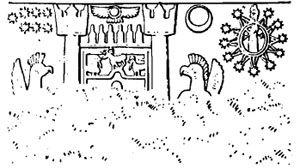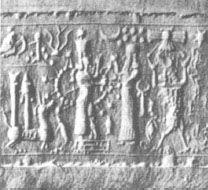The 12th Planet (28 page)
Authors: Zecharia Sitchin
Tags: #Non-Fiction, #Gnostic Dementia, #Fringe Science, #Retail, #Archaeology, #Ancient Aliens, #History

Irrespective of the theological implications, the literal and original meaning of the verses cannot be escaped: The sons of the gods who came to Earth from the heavens were the Nefilim.
And the Nefilim were the People of the Shem—the People of the Rocket Ships. Henceforward, we shall call them by their biblical name.
6
•
THE TWELFTH PLANET
The suggestion that Earth was visited by intelligent beings from elsewhere postulates the existence of another celestial body upon which intelligent beings established a civilization more advanced than ours.
Speculation regarding the possibility of Earth visitation by intelligent beings from elsewhere has centered, in the past, on such planets as Mars or Venus as their place of origin. However, now that it is virtually certain that these two planetary neighbors of Earth have neither intelligent life nor an advanced civilization upon them, those who believe in such Earth visitations look to other galaxies and to distant stars as the home of such extraterrestrial astronauts.
The advantage of such suggestions is that while they cannot be proved, they cannot be disproved, either. The disadvantage is that these suggested "homes" are fantastically distant from Earth, requiring years upon years of travel at the speed of light. The authors of such suggestions therefore postulate one-way trips to Earth: a team of astronauts on a no-return mission, or perhaps on a spaceship lost and out of control, crash-landing upon Earth.
This is definitely
not
the Sumerian notion of the Heavenly Abode of the Gods.
The Sumerians accepted the existence of such a "Heavenly Abode," a "pure place," a "primeval abode." While Enlil, Enki, and Nin
h
ursag went to Earth and made their home upon it, their father Anu remained in the Heavenly Abode as its ruler. Not only occasional references in various texts but also detailed "god lists" actually named twenty-one divine couples of the dynasty that preceded Anu on the throne of the "pure place."
Anu himself reigned over a court of great splendor and extent. As Gilgamesh reported (and the Book of Ezekiel confirmed), it was a place with an artificial garden sculpted wholly of semiprecious stones. There Anu resided with his official consort Antu and six concubines, eighty offspring (of which fourteen were by Antu), one Prime Minister, three Commanders in charge of the
mus
(rocket ships), two Commanders of the Weapons, two Great Masters of Written Knowledge, one Minister of the Purse, two Chief Justices, two "who with sound impress," and two Chief Scribes, with five Assistant Scribes.
Mesopotamian texts refer frequently to the magnificence of the abode of Anu and the gods and weapons that guarded its gateway. The tale of Adapa reports that the god Enki, having provided Adapa with a
shem,
Made him take the road to Heaven,
and to Heaven he went up.
When he had ascended to Heaven,
he approached the Gate of Anu.
Tammuz and Gizzida were standing guard
at the Gate of Anu.
Guarded by the divine weapons SHAR.UR ("royal hunter") and SHAR.GAZ ("royal killer"), the throne room of Anu was the place of the Assembly of the Gods. On such occasions a strict protocol governed the order of entering and seating:
Enlil enters the throne room of Anu,
seats himself at the place of the right tiara,
on the right of Anu.
Ea enters [the throne room of Anu],
seats himself at the place of the sacred tiara,
on the left of Anu.
The Gods of Heaven and Earth of the ancient Near East not only originated in the heavens but could also return to the Heavenly Abode. Anu occasionally came down to Earth on state visits; Ishtar went up to Anu at least twice. Enlil's center in Nippur was equipped as a "bond heaven-earth." Shamash was in charge of the Eagles and the launching place of the rocket ships. Gilgamesh went up to the Place of Eternity and returned to Uruk; Adapa, too, made the trip and came back to tell about it; so did the biblical king of Tyre.
A number of Mesopotamian texts deal with the
Apkallu,
an Akkadian term stemming from the Sumerian AB.GAL ("great one who leads," or "master who points the way"). A study by Gustav Guterbock
(Die Historische Tradition und Ihre Literarische Gestaltung bei Babylonier und Hethiten)
ascertained that these were the "bird-men" depicted as the "Eagles" that we have already shown. The texts that spoke of their feats said of one that he "brought down Inanna from Heaven, to the E-Anna temple made her descend." This and other references indicate that these Apkallu were the pilots of the spaceships of the Nefilim.
Two-way travel was not only possible but actually contemplated to begin with, for we are told that, having decided to establish in Sumer the Gateway of the Gods (Babili), the leader of the gods explained:
When to the Primeval Source
for assembly you shall ascend,
There shall be a restplace for the night
to receive you all.
When from the Heavens
for assembly you shall descend,
There shall be a restplace for the night
to receive you all.
Realizing that such two-way travel between Earth and the Heavenly Abode was both contemplated and practiced, the people of Sumer did not exile their gods to distant galaxies. The Abode of the Gods, their legacy discloses, was within our own solar system.
We have seen Shamash in his official uniform as Commander of the Eagles. On each of his wrists he wears a watchlike object held in place by metal clasps. Other depictions of the Eagles reveal that all the important ones wore such objects. Whether they were merely decorative or served a useful purpose, we do not know. But all scholars are agreed that the objects represented rosettes—a circular cluster of "petals" radiating from a central point. (Fig. 86)
The rosette was the most common decorative temple symbol throughout the ancient lands, prevalent in Mesopotamia, western Asia, Anatolia, Cyprus, Crete, and Greece. It is the accepted view that the rosette as a temple symbol was an outgrowth or stylization of a celestial phenomenon—a sun encircled by its satellites. That the ancient astronauts wore this symbol on their wrists adds credence to this view.
An Assyrian depiction of the Gateway of Anu in the Heavenly Abode (Fig. 87) confirms ancient familiarity with a celestial system such as our Sun and its planets. The gateway is flanked by two Eagles—indicating that their services are needed to reach the Heavenly Abode. The Winged Globe—the supreme divine emblem—marks the gateway. It is flanked by the celestial symbols of the number seven and the crescent, representing (we believe) Anu flanked by Enlil and Enki.
Where are the celestial bodies represented by these symbols? Where is the Heavenly Abode? The ancient artist answers with yet another depiction, that of a large celestial deity extending its rays to eleven smaller celestial bodies encircling it. It is a representation of a Sun, orbited by eleven planets.
That this was not an isolated representation can be shown by reproducing other depictions on cylinder seals, like this one from the Berlin Museum of the Ancient Near East. (Fig. 88)
When the central god or celestial body in the Berlin seal is enlarged (Fig. 89), we can see that it depicts a large, ray-emitting star surrounded by eleven heavenly bodies—planets. These, in turn, rest on a chain of twenty-four smaller globes. Is it only a coincidence that the number of all the "moons," or satellites, of the planets in our solar system (astronomers exclude those of ten miles or less in diameter) is also exactly twenty-four?
Now there is, of course, a catch to claiming that these depictions-of a Sun and
eleven
planets—represent
our
solar system, for our scholars tell us that the planetary system of which Earth is a part comprises the Sun, Earth and Moon, Mercury, Venus, Mars, Jupiter, Saturn, Uranus, Neptune, and Pluto. This adds up to the Sun and only ten planets (when the Moon is counted as one).
But that is not what the Sumerians said. They claimed that our system was made up of the Sun and eleven planets (counting the Moon), and held steadfastly to the opinion that, in addition to the planets known to us today, there has been a
twelfth
member of the solar system—the home planet of the Nefilim.
We shall call it the
Twelfth Planet.
•
Before we check the accuracy of the Sumerian information, let us review the history of our own knowledge of Earth and the heavens around it.
We know today that beyond the giant planets Jupiter and Saturn—at distances insignificant in terms of the universe, but immense in human terms—two more major planets (Uranus and Neptune) and a third, small one (Pluto) belong to our solar system. But such knowledge is quite recent. Uranus was discovered, through the use of improved telescopes, in 1781. After observing it for some fifty years, some astronomers reached the conclusion that its orbit revealed the influence of yet another planet. Guided by such mathematical calculations, the missing planet—named Neptune—was pinpointed by astronomers in 1846. Then, by the end of the nineteenth century, it became evident that Neptune itself was being subjected to unknown gravitational pull. Was there yet another planet in our solar system? The puzzle was solved in 1930 with the observation and location of Pluto.
Up to 1780, then, and for centuries before that, people believed there were
seven
members of our solar system: Sun, Moon, Mercury, Venus, Mars, Jupiter, Saturn. Earth was not counted as a planet because it was believed that these other celestial bodies circled Earth—the most important celestial body created by God, with God's most important creation, Man, upon it.

Fig. 86

Fig. 87

